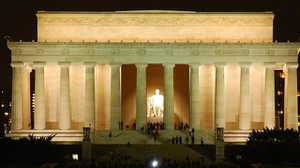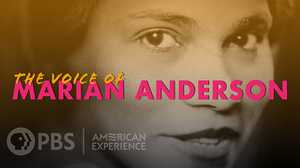How Marian Anderson Became the Voice of the Century
Before the legendary singer was a civil rights icon at home, she battled white supremacy abroad.

In 1930, Marian Anderson journeyed across the Atlantic to Europe for opportunities to study and tour beyond the limited offerings of Jim Crow America. Far from her home in Philadelphia, she found success surpassing any she had experienced in the U.S. Her popularity in Scandinavia was so great, for example, that fans were said to have “Marian fever.” But Anderson was unable to escape racist hostilities abroad.
In 1935, near the end of an extensive tour that included performances in England, France, Sweden and Russia, the cardinal archbishop of Salzburg, Sigismund Waitz, came to meet Anderson backstage after a concert in Vienna. He proposed that she perform a charity concert at the Salzburg Cathedral as part of the calendar of the renowned Salzburg Festival. The annual music and artistic program, held against the Baroque backdrop of Mozart’s hometown, draws the world’s most distinguished and talented artists for multiple days of opera, drama and musical performances.

Growing Nazi sentiment in Austria made this invitation a fraught, and even dangerous prospect. When the African American baritone Aubrey Pankey performed in Salzburg just a couple of years earlier, he was chased from the city by a Nazi mob. So when Anderson petitioned to sing there at Cardinal Waitz’s behest, the Salzburg Festival authorities banned her performance. The singer found herself at the center of a scandal she did not want, with international media outlets covering the Salzburg concert prohibition. Under pressure to explain their refusal to host Anderson, the Salzburg organizers claimed Anderson’s request to sing had simply come too late. “Baron Puthon, president of the Salzburg Festival committee, said it was not possible for his organization to have Miss Anderson’s concert scheduled within the Festival program because it had been prepared months ago,” reported The New York Times. “He said the concert had not been barred and that he knew no reason for Miss Anderson’s complaint.”
In fact, she had made no known complaint. Anderson had an uneasy relationship with politics throughout her career; she was an artist, not an activist, and it was on the merits of her art that she asked to be judged. Anderson made no comment to the press regarding the festival’s refusal to include her on its program. Rather, she graciously embraced the festival organizers’ attempt to stem public scandal: She could sing in a Salzburg venue, but not as part of the official performance calendar.

On the festival’s first night, she gave the permitted, unendorsed concert at the Mozarteum. Though the recital started small, during the intermission, word of Anderson’s talent spread—her remarkable vocal range extended from tenor to mezzo-soprano—and by the concert’s second half her audience had grown noticeably larger. In a review the next day, even a local critic allowed that “the Negro singer” had given a remarkable performance. Still, the Salzburger Volkblatt reporter could not help but exoticize Anderson: “the lady is, in so far as a white person is entitled to a judgment of taste, a charming lively figure,” he wrote. “In a long, white, low-necked silk dress, on her neck a giant, pale-red flower, she looks as if she has for far too long bathed in the sun of Africa.”
Anderson made her greatest impression in the Alps in a second, private recital organized by a well-to-do American patron of the arts. Hundreds attended this concert several days later. Religious leaders, diplomats, distinguished government officials and many of the festival’s headlining performers gathered in the ballroom of the Hôtel de l’Europe, both to make a public show against the fascist fervor engulfing Europe and simply to hear her sing.
She opened the concert with two popular arias, one British and the other Italian, followed by well-known compositions by four Germans—Handel, Schubert, Brahms and Mahler—before moving on to two songs by Sibelius, a Scandinavian composer with whom she had worked closely. Then she concluded, as she often did in appearances before predominately white audiences, with a selection of African American spirituals.
Sometimes a song is just a song, but, as Marian Anderson recognized throughout her career, sometimes it is much more than that. By placing spirituals created by enslaved African Americans alongside the so-called high art of Europe, Anderson insisted on the equal merits of both. She shifted the terms of connoisseurship and engagement around her performance in a subversive rebuke to the powers who, on the basis of her skin tone, had tried to deny her the opportunity to perform.
The recital was spellbinding. “Her superb voice commanded the closest attention of that audience from the first note,” one attendee recalled later, adding that “[a]t the end of the spiritual there was no applause at all—a silence instinctive, natural and intense, so that you were afraid to breathe. What Anderson had done was something outside the limits of classical or romantic music.”
Congratulatory audience members visited Anderson after the concert, among them the world-renowned Italian conductor Arturo Toscanini. “What I heard today,” the revered maestro declared in his native Italian, “one is privileged to hear only once in a hundred years.” His praise would come to define the rest of her career. After her agent spun it to the press, Anderson would henceforth be known as “the voice of a century.”
Four years later, on the steps of the Lincoln Memorial, Marian Anderson gave a concert that stood as a bold claim for the ideal of American racial equality. In answer to the Daughters of the American Revolution who would not permit her to perform at their Constitution Hall, the concert hallowed the memorial as a site of victory in the Black freedom struggle. That Easter Sunday performance vaulted her to a kind of patron sainthood for Black excellence overcoming white supremacy.

In an interview years later, Anderson compared the feeling she had at the Lincoln Memorial concert to this more intimate moment in 1935. “The only thing that came near to it was the time when Toscanini came backstage in Salzburg,” she said of stepping out to meet a crowd of 75,000 in her homeland. “My heart was throbbing to the point that I could scarcely hear anything. And there was an excitement that made one, well, you just couldn't, one couldn't say anything.”
What Anderson could not say she channeled into music. It was a message that, through her legendary vocal performances, resonated with striking clarity: the triumph of Black humanity over those who would deny it.









